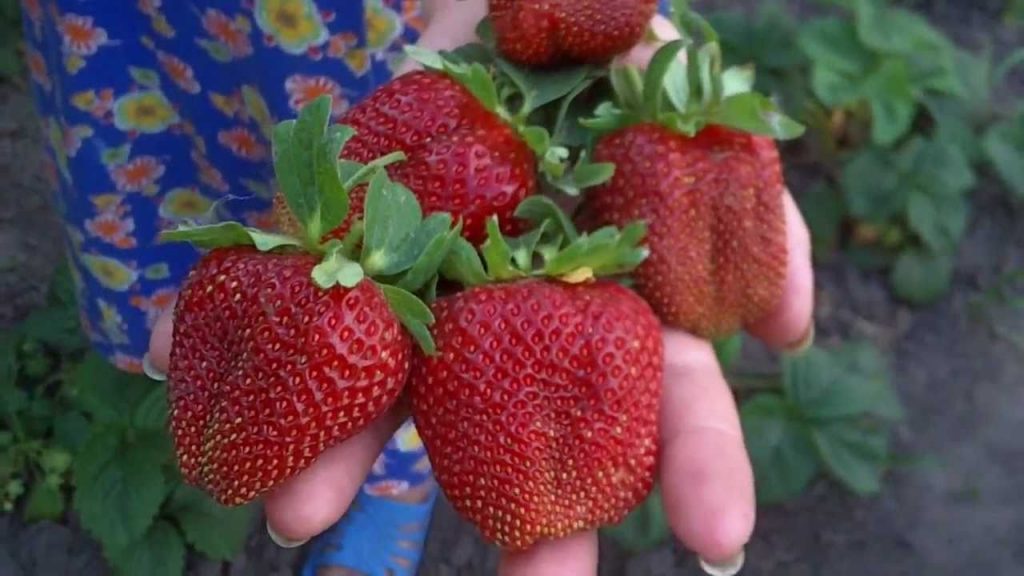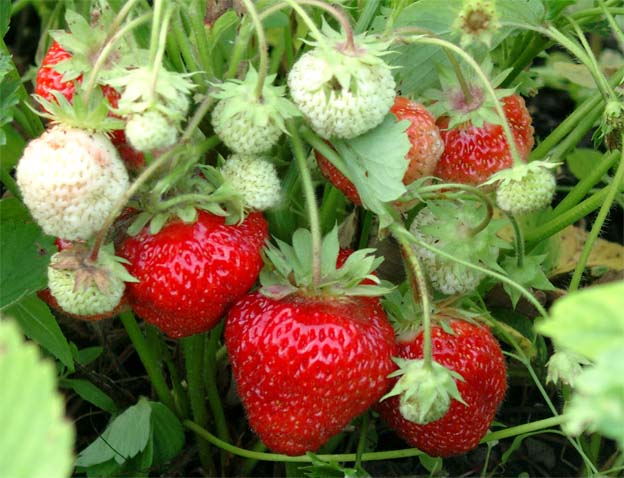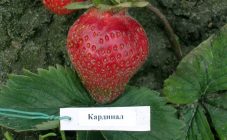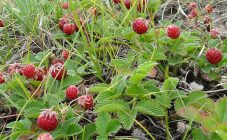One of the most popular medium-ripening strawberries is the Marshal strawberry. This is due to the properties of culture and its benefits.
Strawberry Marshal: variety description and characteristics
The variety is bred by American breeders. Among the main features can be identified the ability to take root in areas with different climatic conditions and soil types. The culture is able to tolerate drought well.
The bush is quite large. Large leaves of a rich green color are formed on it. During the flowering period, flower stalks develop on a long stem. The bush forms tendrils and young rosettes in a short time, which provides the possibility of its reproduction.
Garden strawberries produce red berries with a shiny, even skin. The weight of one fruit can range from 44 to 66 grams. The pulp of the berry is dense, juicy and sweet in taste.
From one bush, you can get up to 1 kg of fruit. The first crop ripens within 1 year after planting.
The disadvantage of this variety is the low level of transportability.
Features of agricultural technology
You can propagate strawberries by seeds, dividing a bush or rosettes. Experienced gardeners recommend using bush division or rosettes. These breeding options are considered the most affordable and effective.
If it was decided to propagate strawberries with seeds, they must be sown in early February. For this, containers made of plastic or peat cups filled with soil mixture are used. For its preparation, peat, ash, sand and soil from the garden are mixed in equal amounts.
When the first 2 true leaves on young plants, the crops must be thinned out. If the seedlings are too thick, the seedlings will stretch out and weaken. 30 - 35 days after the appearance of the entrances, the seedlings need to be prepared for planting in open ground. To do this, they take her outside for a few minutes. Each time, the duration of hardening gradually increases and is brought to 3 - 4 hours. Thanks to this, the seedlings will be ready for possible spring frosts after planting in the beds.
Strawberries are picky crops that require attention and care. For planting seedlings in open ground, it is better to choose the middle of summer. So, before the onset of winter, the bushes will have time to take root and get stronger.
It is recommended to disinfect the seedlings before planting. To do this, the roots must be placed in a weak solution of potassium permanganate for 1 - 2 hours. After this time, rinse the roots in clean water. Thanks to this simple technique, it will be possible to destroy all pathogenic fungi and microorganisms on the root system and increase the degree of survival.
Since strawberry bushes of this variety are quite powerful, the minimum distance between them should be at least 30 cm. In this case, they will not interfere and shade each other, providing high yields.
The area where you plan to plant strawberries should be well lit. The depth of groundwater is at least 100 cm. Otherwise, rotting of the root system of plants cannot be avoided.
Strawberries will thrive and bear fruit well in an area with these types of soil:
- loamy;
- sandy loam;
- slightly acidic.
If the fertility of the soil leaves much to be desired, the site must be dug up and fertilized with humus before planting.
The seedlings are placed in the holes. Their depth should be such that the strawberry roots can be freely spread. If the roots are compressed or deformed, the plant will grow slowly and yield will decrease.
The best predecessors of the culture are spinach, radishes, carrots, garlic, celery, tulips, marigolds and daffodils. If potatoes or cucumbers were grown in front of the strawberries on the site, this will slow down the growth of the berries.
Despite the fact that strawberries of this variety are able to tolerate dry periods well, it is necessary to ensure their timely watering. On average, it is recommended to water a strawberry garden 2 times a week. It is better to water the plants in the evening or early in the morning, so that the drops of water that fall on the leaf blades do not cause burns under the influence of sunlight. For the free release of excess moisture on the site, there must be an effective drainage system.
When the plant enters the flowering stage, the frequency of watering must be reduced by 2 times, otherwise the berries will be watery and less aromatic.
To maintain soil moisture for several days, the soil under the bushes must be mulched after watering. To do this, you can use sawdust, hay or dry grass.
To provide oxygen access to the root system, the aisles must be periodically loosened, removing weeds.
Gardeners should monitor the soil in the strawberry area. It is recommended to feed it using the following types of fertilizers:
- mullein solution;
- chicken droppings;
- wood ash;
- saltpeter.
Top dressing is best done in early summer and autumn. It is better to apply fertilizers simultaneously with loosening the soil.
If the bushes grow slowly, this may indicate that there is not enough potassium in the soil. It is recommended to fertilize the site with saltpeter or wood ash.
Strawberry bushes need to be prepared for the cold season. For this, dried leaves and peduncles are removed on them. Some gardeners practice completely cutting off the ground part of the plant. This is not recommended, otherwise in the spring the bushes will use their strength to form green mass, and not flower stalks.
Since the Marshal strawberry has a high level of frost resistance, there is no need to insulate the plant root system. It is enough to add sawdust or hay between the rows.
Preventive treatment of bushes from harmful insects is best done during the period of flowering and growth of the ovary.
Experienced gardeners plant marigolds or calendula in the aisles of strawberries. This will provide protection from harmful insects.
If the plant shows signs of infection with fungal diseases, it is necessary to remove its antennae and damaged leaves. After that, the bushes are treated with fungicides. Otherwise, the disease will quickly spread to the entire site and destroy the crop.
If the Marshal's yield is low, this may be due to the following reasons:
- high level of soil moisture;
- incorrectly selected plant watering regime;
- hot or cold summers;
- damage to bushes by pests or diseases;
- insufficient amount of nutritional components;
- excessive use of nitrogen fertilizers.
Compliance with the conditions of agricultural technology will ensure good growth of healthy plants and an excellent harvest of tasty healthy berries.














